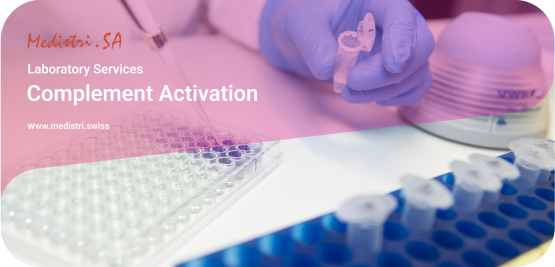(Download: Complement Activation in PDF by Medistri)
The complement system is part of the innate immune system and plays an important role in host defense, inflammation, tissue regeneration and other physiological processes. Complement activation leads to the opsonization of pathogens and their elimination by phagocytes. It also causes chemotactic attraction of phagocytes and macrophages. In addition, the complement system forms the terminal attack complex (MAC), a membrane channel that causes osmotic lysis of the pathogen of interest. Although complement is not adaptive, it complements the adaptive immune system and is also involved in the regulation of the B and T cell response.
Innate immune mechanisms, including the complement system, are the first line of defense of a higher organism against infectious agents from the external environment. Complement activation takes place through three different pathways of complement activation depending on the nature of the pathogen: the classical pathway, the lectin pathway and the alternative pathway. These three pathways converge on the common terminal pathway that leads to the formation of the MAC. This complex is a form of terminal complement complex from SC5b-9 that mediates the irreversible damage to the target cell membrane associated with complement activation.
Activation of the complement system by a medical device or other foreign material can have deleterious effects including tissue damage and inflammation. The ISO 10993-4:2017 standard describes the biological evaluation in general terms and may not necessarily provide sufficient guidance for test methods for a specific device. This standard recommends that the following medical devices be tested specifically for complement activation:
- Extracorporeal membrane oxygenator system.
- Hemodialysis/hemofiltration equipment.
- Percutaneous circulatory support devices.
- Devices for absorption of specific substances from blood, donors and therapeutic apheresis equipment.
- Intra-aortic balloon pumps.
👉 Haemocompatibility testing is essential for assessing the interactions of medical devices in contact with blood. ISO 10993-4:2017 provides general requirements for the evaluation of medical device interactions with blood under five categories of testing (Thrombosis, Coagulation, Platelets, Hematology and Complement System). It describes:
- A classification of medical devices that are intended for use in contact with blood, based on the intended use and duration of contact as defined in ISO 10993-1.
- The fundamental principles governing the evaluation of the interaction of devices with blood.
- The rationale for structured selection of tests according to specific categories, together with the principles and scientific basis of these tests.
The only test recommended to be performed is the incubation of the test article and predicate directly in human serum (or whole blood) and the measurement of the complement protein SC5b-9, using commercially ELISA kits. Analysis of variance (ANOVA) is used to compare the test article and predicate devices to determine if there are statistically significant differences in the mean populations.
Medistri’s in-house laboratory possesses an in-depth comprehension of the Complement Activation process to meet your regulatory requirements.
🎯 To learn more about Medistri’s Complement Activation testing services, visit on our website at www.medistri.swiss or directly contact our team at [email protected].
- The Medistri Team
#Medistri
